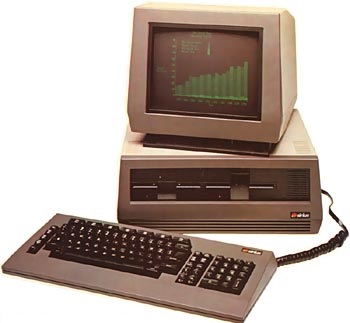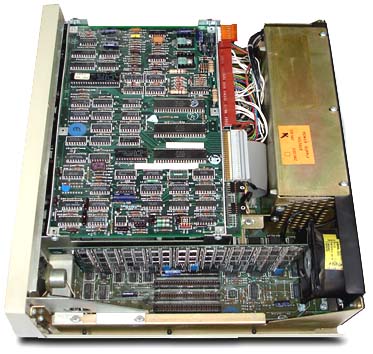![]()
Victor 9000 / Sirius 1

The Victor 9000 (distributed in the UK by British company Applied Computer Techniques as the ACT Sirius 1, and in Australia by Barson Computers as the Sirius 1) was designed by Peddle, who had also designed the first Commodore PET. His team began work in January 1981 and showed a prototype in April. It appeared for the first time at the Systems [de] show in Munich, Germany, in late 1981. Chuck Peddle used two of his Commodore contacts to set up two subsidiaries in continental Europe. David Deane (France) and Jürgen Tepper (Germany) were both ex-Mannesmann Tally whom Chuck had met while negotiating an OEM deal for printers.
The Victor 9000/Sirius 1 ran CP/M-86 and MS-DOS but did not claim to be IBM PC compatible. It offered a higher resolution screen and 600 KB/1.2 MB floppy drives. Advertisements cited the graphics, multiple operating systems, 128 KB of RAM, and high-quality audio. One striking difference between it and other machines on the market at the time was the fact that the disc utilized a form of zoned constant linear velocity (ZCLV) (using 9 different speed-zones selected out of 15 supported by the hardware) with a variant of zone bit recording (ZBR) (11 to 19 sectors depending on zone) to spun at different speeds according to where the data was stored, running slower towards the outer edge of the disc in such a way that bit density (bits per cm passing the head), rather than rotational speed, was approximately constant. This, combined with group-coded recording (GCR), allowed standard floppy disks to hold more data than others at the time, 600 KB on single- and 1.2 MB on double-sided floppies compared with 140–160 KB per side of other machines such as the Apple II and early IBM PC, but disks made at constant bit density were not compatible with machines with standard drives. The Victor 9000's 800x400 resolution screen (based on a Hitachi 46505 CRT controller chip - equivalent to a Motorola 6845), 896 KB of memory (RAM), programmable keyboard and character set were also far ahead of the competition.
While unsuccessful in North America, Victor 9000 became the most popular 16-bit business computer in Europe, especially those in Britain and Germany, while IBM delayed the release of the PC there. Its success led to the ACT Apricot. ACT outsold the Sirius/Victor subsidiaries and also led the way in proving that application software was the key to sales. Most sales across Europe went through small systems houses rather than computer shops.
The Victor 9000 was also distributed in the UK under that name by DRG Business Machines in Weston super-Mare, who dealt with Victor Technologies in the US direct. It was not a particularly successful venture as ACT had already established a brand name and a loyal dealer base.
Year release; 1982
- Model; 9000
- CPU; Intel 8088@5 Mhz
- CPU Speed; 12 Mhz
- RAM; 128 KB 896 KB
- 2 x floppy drives 5 1/4-inch
- 2 serial 1 parallel
- O/S; CP/M-86 MsDOS
- 80x25 Text
- Graphic Display; 800x400 - 8 greys
- Price: US$4,995

The Inside of The Victor 9000
